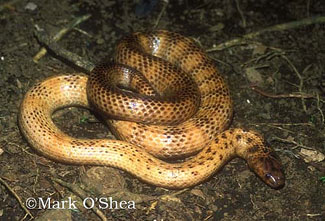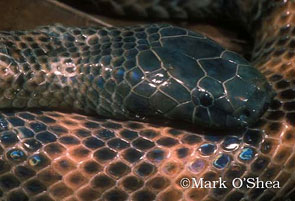The New Guinea small-eyed snake is a secretive nocturnal elapid with a striking patterning that ranges from red bands on a white background in juveniles, to buff or brown bands on a lighter brown background in adults.
Distribution: New Guinea.
Habitat: Coconut plantations and rainforests.
Diet: Lizards, snakes, small mammals, possibly also frogs.
Max.length: 1.2-1.7 m SVL (1.5-2.0 m TL).
Reproductive strategy: Oviparous, clutch size unknown.
The New Guinea small-eyed snake is a secretive nocturnal elapid with a striking patterning that ranges from red bands on a white background in juveniles, to buff or brown bands on a lighter brown background in adults. Bands are more numerous posteriorly, and the tail may be entirely dark. The head is usually grey, and the eyes are small. Small-eyed snakes bite plantation workers, grass-cutters and villagers. They encounter these snakes abroad at night or in the early morning, especially during the wet season. The snakes are easiest to find in the drier weather when they are hidden inside the coconut husk piles.

Mark O' Shea
New Guinea small-eyed snakes are local only to the island of New Guinea.
ELISA (enzyme-linked immunosorbant assay) analysis at the Liverpool School of Tropical Medicine compared venom (collected by myself) with serum samples from fatal snakebite victims from Madang hospitals. This proved what we long considered possible — that the small-eyed snake is capable of delivering a fatal bite to humans. Currently, there is no specific antivenom, though the expensive CSL Australo-Papuan polyvalent does work. Apparently the CSL Tigersnake antivenom does too, although the CSL Death adder commonly held in Madang hospitals is inappropriate.
The small-eyed snake is a fairly powerful and aggressive species when it is captured. It will strike to the side like a krait, and it has a powerful neck, so it requires considerable restraint. I have witnessed both ophiophagy (on a ground boa) and cannibalism in this species, but both are common elapid practices. I do not currently recognize the subspecies designation of M. i. fasciatus, purportedly from the Aru Islands. In canvassing 33 institutions and museums worldwide, I located more 200 specimens of M. ikaheka from almost 100 locations but none were afforded subspecies status. I have collected and milked upwards of 40 specimens in the field for venom research purposes.

Mark O'Shea
The small-eyed snakes are also called the "land eel".
The alternative common name, Ikaheka snake, and the trivial name ikaheka relate to an West Papuan dialect name for “land eel.”
Sources for more information:
Blasco, P. and R.W. Hornabrook. 1972. “Case reports – A neglected but potentially dangerous New Guinea snake – the small-eyed snake (Micropechis ikaheka).” Papua New Guinea Medical Journal 15(3):155-156.
Hudson, B.J. 1988. “The small-eyed snake (Micropechis ikaheka): A review of current knowledge.” Papua New Guinea Medical Journal 31(3):173-178.
Hudson, B.J. and K. Pmat. 1988. “Ten years of snake bite in Madang Province, Papua New Guinea.” Transactions of the Royal Society of Tropical Medicine and Hygiene 82:506-508.
McDowell, S.B. 1970. “On the status and relationships of the Solomon Island elapid snakes.” Journal of the Zoological Society of London 161:145-190.
O’Shea, M. 1990. “The highly and potentially dangerous elapids of Papua New Guinea.” pp.585-640 in Gopalakrishnakone & Chou (eds.) Snakes of Medical Importance (Asia-Pacific region). Univ. Singapore Press.
O’Shea, M. 1994. “Micropechis ikaheka (Small-eyed or Ikaheka snake) Ophiophagy.” Herpetological Review 25(2):70.
O’Shea, M. 1994. “Micropechis ikaheka (Small-eyed or Ikaheka snake) Cannibalism.” Herpetological Review 25(2):70-71.
>
O’Shea, M. 1994. “The herpetofauna of coconut husk piles on Kar Kar Island, Madang Province, Papua New Guinea: The initial surveys.” ASRA Journal 1994:51-72.
O’Shea, M. 1996. A Guide to the Snakes of Papua New Guinea. Independent Pub. xii+239.
Nirthanan, S., R. Gao, P. Gopalakrishnakone, M.C.E. Gwee, H.E. Khoo, L.S. Cheh and R.M. Kini. 2002. “Pharmacological characterization of mikatoxin, an alpha-neurotoxin isolated from the venom of the New Guinean small-eyed snake Micropechis ikaheka.” Toxicon 40(7):863-871.
Parker, F. 1982. The Snakes of Western Province. PNG Dept. of Lands and Environment 82/1. pp.1-78.
Shine, R. and J.S. Keogh. 1996. “Food habits and reproductive biology of the endemic Melanesian elapids: Are tropical snakes really different?” Journal of Herpetology 30(2):238-247.
Warrell, D.A., B.J. Hudson, D.G. Lalloo, A.J. Trevett, P. Whitehead, P. Balmer, J.R. Mamy, A. Wiyono, T.L. Richie, D.J. Fryauff, M.T. O'Shea, A. Richards and R.D.G. Theakson. 1996. “The emerging syndrome of envenoming by the New Guinea small-eyed snake Micropechis ikaheka.” Quarterly Journal of Medicine 89:523-530.


